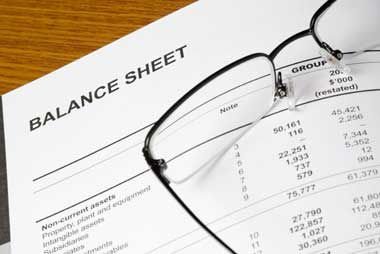:max_bytes(150000):strip_icc():format(jpeg)/BalanceSheet-5bfc2db446e0fb002601d5d8.jpg)
Those who are familiar with balance sheet basics know that a company’s balance sheet offers a snapshot in time of a company’s financial position. You can quickly view a company’s cash position, its assets, as well as its short- and long-term debt obligations. However, did you know that you can better understand the financial situation of a business by performing a few quick calculations using information contained within a balance sheet?
Current Ratio
How do you know if a company has enough cash and short-term assets on hand to pay bills in the short term? Well, using the current assets and current liabilities information presented on a balance sheet, you can determine a company’s current ratio. This ratio is simply calculated as follows:
Current Ratio = Current Assets ÷ Current Liabilities
Most analysts prefer would consider a ratio of 1.2 to two or higher as adequate, though how high this ratio depends upon the business in which the company operates. A higher ratio may signal that the company is accumulating cash, which may require further investigation. If the current ratio falls below one, a business may be in danger of not meeting its short-term liquidity needs.
Quick Ratio
A similarly informative balance sheet metric is a company’s quick ratio. This ratio is a bit more conservative than the current ratio as it removes inventories from the calculation:
Quick Ratio = (Current Assets – Inventories – Prepaid Expenses) ÷ Current Liabilities
Why would an analyst remove inventories from current assets? Inventories carried on a balance sheet cannot necessarily be converted into cash at their book value. For example, some retailers will take significant markdowns to clear their inventory for a new season. In instances such as this, liquidity ratios such as the current ratio are overstated. The quick ratio is an easy way to determine whether a company is able to meet its short-term commitments with current, short-term, liquid assets on hand. A quick ratio that is better than one is generally regarded as safe, but remember that it really depends upon the industry in which the company operates.
Working Capital
The difference between current assets and current liabilities yields a company’s working capital or:
Working Capital = Current Assets – Current Liabilities
Whether a working capital metric should be positive or negative is largely dependent upon the industry in which the company operates. While a positive working capital metric is desirable in certain industries, a negative working capital metric is viewed favorably in others. For example, beverage and restaurant companies tend to negotiate their terms of trade with suppliers such that payment to suppliers is due long after inventories have been converted into cash. Consumer companies with bargaining leverage, such as Walmart stores or Brazilian beverage giant AmBev, tend to operate with working capital deficits. These deficits tend to be viewed favorably by analysts and regarded as efficient use of resources.
Debt/Equity
Finally, one of the most standout ratios derived from a Balance Sheet is the debt-to-equity ratio, which is calculated as:
Debt-to-Equity Ratio = Total Liabilities ÷ Shareholders’ Equity
Just how dependent a business is upon debt can be determined with the debt-to-equity ratio. Essentially, it is a ratio of what is owed to what is owned. In most industries, a lower ratio is viewed more favorably. A high debt to equity ratio signals financial weakness, risk, and an over reliance on debt which is often unsustainable.
The Bottom Line
To better understand a business’s financial situation and level of solvency, you can do a few quick and easy calculations that use data found within the balance sheet. These metrics include the current ratio, quick ratio, working capital and debt-to-equity ratio. Each of these metrics’ ideal value is highly dependent upon the nature of the business in which the company operates, but the numbers are telling all the same. Try using some of these ratios on a few companies’ balance sheets to see what kinds of conclusions you are able to draw from them.

